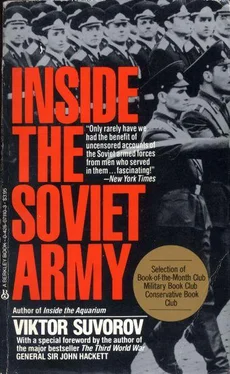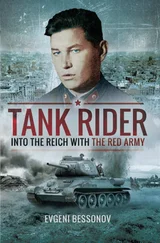When one of these `monkey-models' fell into the hands of Western specialists, they naturally gained a completely false impression of the true combat capabilities of the BMP-1 and of Soviet tanks. For what they were looking at was no more than a casing, or a container, like an empty money box which is of no value without its contents.
The Soviet Union is currently making deliveries abroad of T-72 tanks, MIG-23 fighters and TU-22 bombers. But these are different from the models with which the Soviet Army has armed itself. When one of a man's pockets contains banknotes and the other simply holds pieces of paper, it is quite impossible to tell which is which from the outside.
The current Soviet policy concerning equipment is a wise one-to amass first-class but very simple equipment in quantities sufficient for the first few weeks of a war. If the war continues, equipment will be produced on an enormous scale, but in variants which have been simplified to the greatest possible extent. Experience of producing both standard and `monkey' models is being gained in peacetime; the simpler variants are being sold to the `brothers' and `friends' of the USSR as the very latest equipment available.
1
The winter of 1969 was an exceptionally bitter one in the Soviet Far East. When the first clashes with the Chinese took place on the river Ussuri, and before combat divisions reached the area, the pressure exerted by the enemy was borne by the KGB frontier troops. After the clash was over, the General Staff held a careful investigation into all the mistakes and oversights which had occurred. It was quickly discovered that several KGB soldiers had frozen to death in the snow, simply because they had never received elementary instruction in sleeping out in temperatures below zero.
This was alarming news. A commission from the General Staff immediately carried out experiments with three divisions, chosen at random, and came to a depressing conclusion. Wartime experience had been irrevocably lost and the modern Soviet soldier had not been taught how he could sleep in the snow. Naturally he was not allowed a sleeping bag and of course he was forbidden to light a fire. Normally a soldier would spend nights when the temperature was below freezing-point in his vehicle. But what was he to do if the vehicle was put out of action?
The chiefs of staff of all divisions were immediately summoned to Moscow. They were given a day's instruction in the technique of sleeping out in snow at freezing temperatures, using only a greatcoat. Then each of them was required to convince himself that this was possible, by sleeping in the snow for three nights. (It should be remembered that March in Solnechnogorsk, near Moscow, is a hard month, with snow on the ground and temperatures below zero.) Then the chiefs of staff returned to their divisions and immediately the entire Soviet Army was put to a very hard test-that of spending a night in the open in numbing cold and without any extra clothing. It seemed as if those who were stationed in deserts in the south were in luck. But no-they were sent by turns to either Siberia or the north to be put through the same tough training. Thereafter, spending a night in the snow became a part of all military training programmes.
Two years before this, following the shameful defeats in Sinai, when it had become clear how much Arab soldiers fear tanks and napalm, urgent orders had been issued, making it compulsory for all Soviet soldiers and officers, up to the rank of general, to jump through roaring flames, and to shelter in shallow pits as tanks clattered by just above their heads, or, if they could not find even this protection, to lie on the ground between the tracks of the roaring vehicles.
The Soviet Army re-learned its lessons within a single day. I have felt napalm on my own skin, I have crouched in a pit as a tank crashed by overhead, and I have spent terrible nights in the snow.
At the beginning of the war, the Red Army had no idea how to organise the defence of the country or, particularly, of the large towns. It had never been taught how to do this. It had only learned how to attack and how to `carry the war on to the enemy's territory'. However, the war began in accordance with the plans of the German General Staff rather than of their Soviet opponents. One catastrophe followed another. Attempts to defend Minsk lasted for three days, to hold Kiev for two days. Everyone was at their wits' end to know how to organise things better. Kiev fell at the end of September and by October Guderian was approaching Moscow. Suddenly, something quite astonishing happened. Soviet defences became impenetrable, specifically those around Moscow, Tula and Tver'. For the first time in the course of the Second World War, the German military machine was brought to a standstill. It is said that freezing weather played its part in turning the tide. This was true enough in November and December, but in October the weather was sunny. Something had happened; a radical change had occurred. The next year, the battle for Stalingrad took place-the city was defended throughout the summer, and frosts played no part in the outcome. This campaign will go down in history as a model for the defence of a large city. A second such model is the defence of Leningrad which held out for almost three years, during which one and a half million of its citizens lost their lives. It was under attack for two winters and three summers. Freezing temperatures played no role here either-the city could have been taken during any season in these three years.
In the Soviet Army the dividing line between inability to perform a particular role and the capacity to carry it out with great professional skill is almost indiscernible. Transitions from one to the other occur almost instantaneously, not only in tactics, strategy and the training of personnel but also in equipment programmes.
2
At the beginning of the 1960s a discussion developed in the Western military journals about the need for a new infantry combat vehicle: this must be amphibious, well armoured, and highly manoeuvrable, and must have considerable fire-power. The Soviet military press responded only with a deathly silence. The discussion gathered strength, there was much argument for and against the proposition, intensive tests were carried out… the Soviet Union remained silent.
One night towards the end of 1966 heavy transporters arrived at our military academy carrying unusual vehicles of some sort, which were covered in tarpaulins. These were BMP-1s-amphibious, fiendishly manoeuvrable, well-armoured and heavily armed. By 1967 this vehicle was being produced in great numbers: meanwhile the discussion in the West continued. Only West Germany took any positive steps, by building the `Marder'-which was an excellent vehicle, but was not amphibious and carried almost the same armament as previous German armoured personnel carriers. Sadly, it was also exceptionally complicated in design.
In the early 1980s, the discussion is still in progress in the West; the first tentative steps have been taken, but at present, as before, the United States has armoured personnel carriers which are armed only with machine-guns. Of course, Western specialists have found many faults in the construction of the BMP-1. But this is yesterday's product-and the `monkey model' of it at that. The Soviet Union has been producing a second generation of BMPs in massive quantities for a long time now while, in the West, discussion continues.
The same has happened with military helicopters, self-propelled artillery, automatic mortars and many other types of equipment.
When will we be able to dispense with the tank?
1
One day, in Paris, I bought a book, published in 1927, on the problems of a future war. The author was sober-minded and reasonable. His logic was sound, his analysis was shrewd and his arguments unassailable. After analysing the way military equipment had developed in his lifetime, the author concluded by declaring that the proper place for the tank was in the museum, next to the dinosaur skeletons. His argument was simple and logical: anti-tank guns had been developed to the point at which they would bring massive formations of tanks to a complete halt in any future war, just as machine guns had completely stopped the cavalry in the First World War.
Читать дальше












